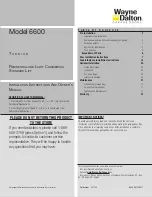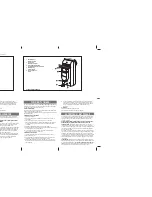
3
Important Safety Instructions
ImPOrtant Safety InStrUCtIOnS
Specific to Secondary
Means of Protection Against Entrapment
As specified by Underwriters Laboratories Inc. UL 325 (30A.1.1), automatic gate operators shall have
provisions
for, or be supplied with,
at least one independent primary and one independent secondary means to protect
against entrapment. GTO gate operators utilize
type a
, an inherent entrapment sensing system, as the
primary
type of entrapment protection. The GP-SL100 operators have provisions for the connection of
type B1, B2,
or
D
protection to be used as the
secondary
type of entrapment protection.
1.
For gate operators utilizing a non-contact sensor (Type B1) in accordance with UL 325 (51.8.4 [h]):
A. Refer to the sensor
manufacturer’s instructions
on the placement of non-contact sensors for each type of
application.
B. Care shall be exercised to reduce the risk of nuisance tripping, such as when a vehicle trips the sensor
while the gate is still moving.
C. One or more non-contact sensors shall be located where the risk of entrapment or obstruction exists,
such as the perimeter reachable by a moving gate or barrier.
2.
For gate operators utilizing a contact sensor (Type B2) in accordance with UL 325 (51.8.4 [i]):
A. One or more contact sensors shall be located at the leading edge, trailing edge, and post mounted both
inside and outside of a vehicular slide gate system.
B. A hard wired contact sensor shall be located and its wiring arranged so that the communication between
the sensor and the gate operator is not subjected to mechanical damage.
C. A wireless contact sensor such as one that transmits radio frequency (RF) signals to the gate operator
for entrapment protection functions shall be located where the transmission of the signals are not
obstructed or impeded by building structures, natural landscaping or similar obstruction. A wireless
contact sensor shall function under the intended end-use conditions.
3.
For gate operators utilizing an actuating device requiring continuous pressure to maintain opening or
closing motion of the gate (Type D) in accordance with UL 325 (51.8.4 [e]):
A. The gate operator controls must be placed so that the user has full view of the gate area when the gate
is moving.
B. Warning signs
(see page 6)
shall be placed adjacent to the controls.
C. An automatic closing device (timer, loop sensor, etc.) shall not be employed.
D. No other activation device shall be connected.
ENTRAPMENT ALARM (UL 325; 30A.1.1A)
The GP-SL100 operators are designed to stop and reverse for 2 seconds when the gate comes in contact
with an obstruction or when an object activates the non-contact sensors. Additionally, these operators
are equipped with an
audio entrapment alarm
which will function if the unit obstructs
twice
while
opening or closing. This alarm will sound for a period of 5 minutes or until the operator receives an
intended signal (e.g., transmitter signal) and the gate returns to a fully open or fully closed position.







































